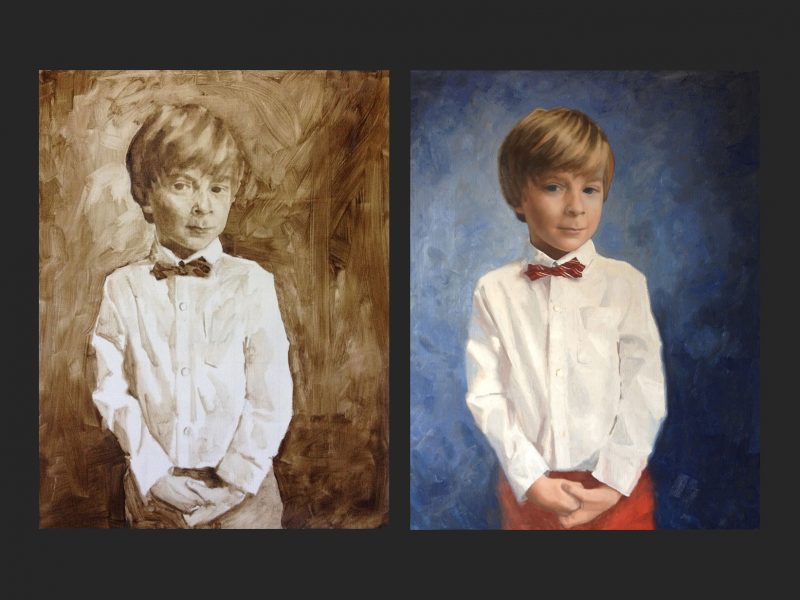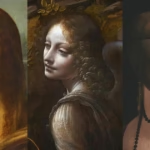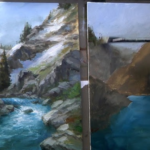Glazing in classical painting is a captivating technique that has long been revered for its ability to create breathtaking luminosity and depth in artwork. This method, far more intricate than simply applying a thin transparent layer of color, demands patience, emotional intelligence, and a profound understanding of light and pigment from the artist. Glaze is typically crafted by blending pigments with a suitable glazing medium, often oil-based, to achieve a lifelike, dynamic layer that shifts with perspective and natural light. The glazing technique not only enhances details and contours but also imbues paintings with an air of mystery and radiance, bringing them to life whether viewed from afar or up close. As we delve deeper into this fascinating world of glazing, we’ll uncover the secrets that have allowed master painters throughout history to capture the essence of light and shadow on canvas, creating works that continue to captivate viewers centuries later.
The Foundations of Glazing Technique
The art of glazing is a cornerstone of classical painting, rooted in a deep understanding of how light interacts with layers of pigment. This technique has been refined over centuries, allowing artists to achieve an unparalleled depth and luminosity in their works. Before we explore the intricacies of glazing, it’s essential to grasp its fundamental principles and the materials that emphasize the luminosity of paint.
The Science Behind the Glow
Glazing relies on a fascinating interplay between light, pigment, medium, and the human eye. When light penetrates the translucent layers of glaze, it reflects off the opaque underlayers, creating a luminous effect that seems to emanate from within the painting itself. This phenomenon is similar to how sunlight filters through stained glass, with each layer of glaze acting as a colored lens that modifies the light passing through it.
The physics of glazing involves concepts such as refraction and light transmission. As light travels through the glaze layers, it bends and disperses, interacting with pigment particles along the way. This interaction results in a complex play of color and illumination that the naked eye perceives as a rich, vibrant hue with remarkable depth.
Understanding this process allows artists to manipulate light and color in ways that opaque painting techniques simply cannot achieve. By carefully controlling the thickness and composition of each glaze layer, painters can create subtle variations in tone, intensity, and optical depth, mimicking the way light behaves in the natural world.
Essential Materials for Glazing
The success of glazing techniques hinges on the quality and properties of the materials used. The most crucial components are the pigments, mediums, and supports that form the foundation of the glazing process.
Pigments for glazing must be carefully selected for their transparency and tinting strength. Historically, artists relied on natural pigments derived from minerals, plants, and even insects. Today, synthetic alternatives offer a wider range of options, but many artists still prefer traditional pigments for their unique optical properties.
The medium used in glazing is equally important. Traditionally, linseed oil has been the medium of choice due to its slow drying time and ability to create a durable, flexible film. However, modern painters may experiment with a variety of mediums, including walnut oil, poppy oil, or even synthetic alternatives, each offering different working properties and finish effects.
The support on which the painting is created plays a crucial role in the overall effect of glazing. A smooth, non-absorbent surface is ideal, as it allows the glaze layers to sit on top rather than being absorbed into the surface itself. Historically, wood panels were preferred for this reason, but well-prepared canvas can also serve as an excellent support for glazed paintings.
Preparing the Ground: The Underpainting

The foundation of a successful glazed painting lies in its underpainting. This initial layer sets the tone for the entire work, providing the structure and value relationships that will be enhanced by subsequent glazes.
Creating an effective underpainting requires forethought and planning. Artists must consider the final color scheme and composition, as the underpainting will influence every layer that follows. Typically, underpaintings are executed in monochrome or limited color palettes, focusing on establishing the correct values and forms.
The choice of colors for the underpainting is crucial. Warm undertones can create a sense of glowing light from within the painting, while cool undertones can lend a sense of atmosphere and distance. Many classical painters used earth tones like raw umber or burnt sienna for their underpaintings, as these colors provided a neutral base that complemented a wide range of glazes.
The texture of the underpainting also plays a role in the final effect. A smooth underpainting allows for even application of glazes, while a more textured approach can add interesting variations and depth to the finished work. Some artists deliberately leave brush strokes visible in the underpainting, knowing that these will add subtle complexity to the glazed layers above.
By mastering these foundational aspects of glazing technique, artists set the stage for creating works of exceptional beauty and depth. The interplay of science, materials, and artistic vision in glazing continues to fascinate painters and viewers alike, bridging centuries of artistic tradition with contemporary practice.
Mastering the Art of Layering

The essence of glazing lies in the meticulous application of multiple translucent layers, each contributing to the overall depth and luminosity of the painting. This process, often likened to the patient building of a symphony, requires a keen eye, steady hand, and deep understanding of color theory. Let’s explore the nuances of this layering technique that has captivated artists for centuries.
The Rhythm of Application
Glazing is not a race but a measured dance between the artist and the canvas. Each layer must be applied with intention and allowed to dry completely before the next is added. This rhythmic process can span days or even weeks, depending on the complexity of the painting and the effects desired.
The first glaze layer is often the most transformative, dramatically altering the appearance of the underpainting. Artists must resist the urge to overwork this initial layer, trusting in the cumulative effect of subsequent glazes. It’s a test of patience and vision, requiring the artist to see beyond the immediate result to the final composition.
As layers build up, the interplay between them becomes increasingly complex. Light penetrates each layer, interacting with the pigments before being reflected back to the viewer’s eye. This creates a depth of color that is impossible to achieve with opaque paint alone. The artist must constantly evaluate how each new layer affects those beneath it, adjusting the intensity and hue of glazes to achieve the desired effect.
Color Theory in Practice
Understanding color theory is crucial for successful glazing. The transparent nature of glazes means that colors interact in ways that can be both predictable and surprising. Artists must have a firm grasp on how colors mix optically when layered, as opposed to the subtractive mixing that occurs on a palette.
Complementary colors play a vital role in glazing. By layering glazes of complementary hues, artists can create rich, vibrant shadows and subtle modulations of tone. For example, a cool blue glaze over a warm orange underpainting can result in a deep, luminous shadow that appears to recede into the canvas.
The concept of temperature in color becomes particularly important in glazing. Warm glazes over cool underpainting can create a sense of light and atmosphere, while cool glazes over warm bases can suggest depth and distance. Mastering these temperature relationships allows artists to create convincing illusions of space and light within their paintings.
Achieving Translucency and Opacity
The balance between translucency and opacity is at the heart of glazing technique. While glazes are inherently transparent, the degree of translucency can be controlled through the ratio of pigment to medium and the thickness of application.
Highly translucent glazes allow more of the underpainting to show through, creating subtle shifts in color and tone. These are often used in the early stages of glazing to build up depth gradually. As the painting progresses, artists may use slightly more opaque glazes to refine forms and add detail.
Scumbling, a technique where a thin layer of opaque or semi-opaque paint is dragged over a dry underlayer, can be used in conjunction with glazing to create interesting textural effects. This interplay between transparent and opaque layers adds another dimension to the painting, allowing artists to suggest form and texture alongside the luminous depth of pure glazes.
The key to mastering translucency lies in understanding how different pigments behave when thinned with medium. Some colors remain transparent even when heavily pigmented, while others quickly become opaque. Artists must experiment with various pigments and mediums to develop an intuitive sense of how to achieve the desired level of translucency for each layer.
By honing their skills in the art of layering, artists can create paintings of extraordinary depth and luminosity. The patient build-up of translucent layers allows for a subtlety of color and light that continues to captivate viewers, making glazing a timeless technique in the world of classical painting.
Advanced Techniques and Effects

As artists progress in their mastery of glazing, they begin to explore more sophisticated techniques that can elevate their work to new heights. These advanced methods allow for greater control over the visual effects and emotional impact of a painting, pushing the boundaries of what is possible with pigment and light.
Creating Atmospheric Perspective
One of the most powerful applications of glazing is in the creation of atmospheric perspective. This technique mimics the way distant objects appear less distinct and take on the color of the atmosphere, creating a convincing sense of depth and space within a two-dimensional painting.
To achieve atmospheric perspective, artists apply progressively cooler and more transparent glazes to areas meant to recede into the distance. This gradual shift in color temperature and clarity mimics the way particles in the air scatter light, making distant objects appear bluer and less defined.
The key to successful atmospheric glazing lies in subtlety. Each layer should be barely perceptible on its own, with the cumulative effect building slowly over multiple applications. Artists might begin with a warm, clear foreground and gradually introduce cooler tones and a slight haziness as the eye moves towards the background.
This technique is particularly effective in landscape painting, where it can create a sense of vast distance and environmental conditions like fog or mist. By carefully controlling the intensity and color of glazes, artists can suggest different times of day or weather conditions, adding another layer of narrative to their work.
Mimicking Textures and Materials
Glazing excels at creating the illusion of different textures and materials, from the soft sheen of silk to the cold hardness of metal. This ability to suggest diverse surfaces within a painting adds richness and realism to the composition.
For reflective surfaces like water or polished metal, artists use a combination of precise underpainting and carefully applied glazes. The underpainting establishes the basic forms and reflections, while thin glazes add depth and the characteristic sheen of the material. Multiple layers of alternating warm and cool glazes can create the complex play of light seen on water’s surface or the subtle color variations in burnished metal.
Translucent materials like glass or certain fabrics present a unique challenge that glazing is particularly well-suited to address. By building up layers of transparent color over a light underpainting, artists can create the illusion of light passing through a material. The key is to observe and replicate the way light behaves as it interacts with these materials, bending and scattering to create areas of brightness and shadow.
Even organic textures like skin or foliage benefit from glazing techniques. The translucent quality of glazes allows artists to suggest the way light penetrates and reflects within these materials, creating a lifelike depth that flat color cannot achieve. For skin tones, alternating warm and cool glazes can suggest the complex interplay of blood vessels, fat, and muscle beneath the surface.
Enhancing Drama and Mood
Perhaps the most powerful aspect of advanced glazing techniques is their ability to enhance the dramatic impact and emotional resonance of a painting. By carefully manipulating light, color, and contrast through glazing, artists can create works that evoke strong emotional responses in viewers.
Chiaroscuro, the strong contrast between light and dark, is one area where glazing truly excels. By building up layers of transparent darks in shadow areas while leaving highlights relatively untouched, artists can create a sense of dramatic illumination that draws the eye and creates focus within the composition.
The color temperature of glazes can significantly influence the mood of a painting. Warm glazes create a sense of intimacy and comfort, while cool glazes can evoke feelings of isolation or melancholy. By selectively applying glazes of different temperatures to various areas of the painting, artists can guide the viewer’s emotional journey through the work.
Vignetting, the gradual fading of the edges of an image, is another technique that benefits from glazing. By applying progressively darker or more muted glazes towards the edges of the composition, artists can create a sense of focus and intimacy, drawing the viewer’s eye to the central elements of the painting.
These advanced techniques require not only technical skill but also a deep understanding of visual perception and emotional response. As artists master these methods, they gain the ability to create works that not only replicate the visual world but also convey complex emotions and narratives through the subtle manipulation of light and color.
Conclusion

In essence, the art of glazing in classical painting epitomizes patience, skill, and artistic vision. This time-honored method, which masterfully captures the interplay of light and color, continues to captivate both artists and viewers. By understanding how light behaves and how colors interact, artists are able to create works that seem to glow from within, inviting viewers to discover new details with each glance.
Glazing’s versatility and adaptability to various styles and subjects, from atmospheric landscapes to lifelike portraits, allows artists to explore new realms of visual expression. In an age of instant gratification, the deliberate and meditative process of glazing provides a counterpoint, reminding us of the value of thoughtful creation and fostering a deeper connection between the artist and their materials.
As we look to the future, it’s clear that glazing techniques will remain vital in the evolving world of painting. While new technologies and materials emerge, the fundamental principles of glazing endure, providing artists with a unique perspective on seeing and interpreting the world. By continuing to refine these methods, we honor the legacy of countless artists and pave the way for new innovations in the timeless art of painting.
✉️ Stay Connected — Subscribe for Weekly Updates
Discover timeless stories, practical wisdom, and beautiful culture — delivered straight to your inbox.
*We only share valuable insights — no spam, ever.






